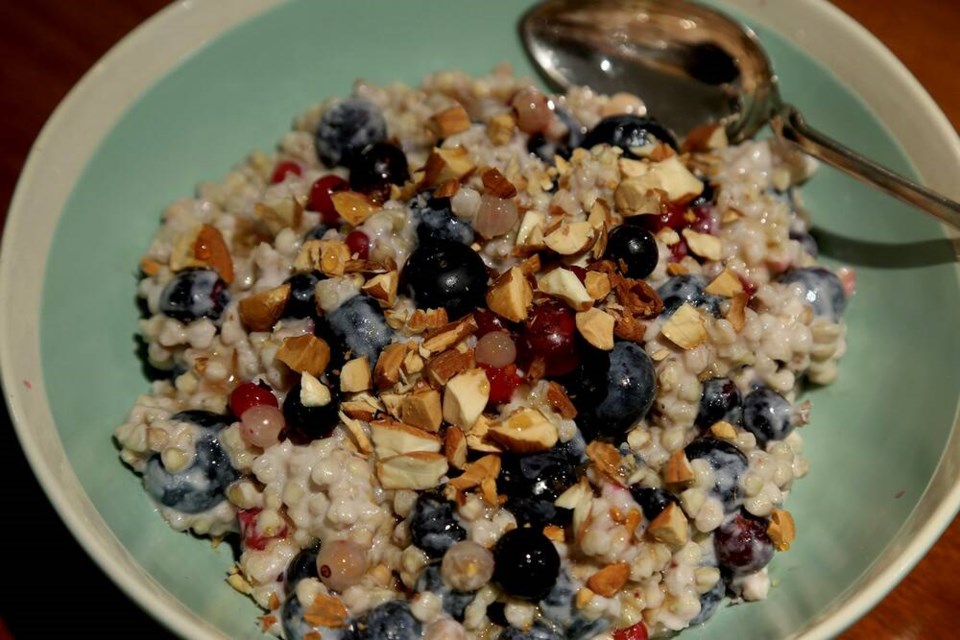These crazy cold mornings have me thinking about tummy-warming buckwheat porridge. So-called buck“wheat” is one of nature’s most nutritious and versatile offerings, but it is not wheat nor grain. It is a seed of the flowering plant Fagopyrum esculentum, a knotweed family plant related to sorrel and rhubarb.
Culinary history confirms that buckwheat has been cultivated for thousands of years, worldwide. The tiny arrow-shaped shaped seedheads were eaten raw, ground into flour, even sprouted. Today buckwheat is categorized as a gluten-free pseudo-cereal along with quinoa and amaranth. Large scale farming of corn and wheat eventually eclipsed buckwheat as a primary commodity, and this beneficial whole food fell out of favour.
In the urban garden, buckwheat is uncommonly resilient. Buckwheat is beneficial cover crop-mulch, and makes for an excellent chop-and-drop green manure. One particularly vigorous variety of buckwheat, called Himalayan Tartary Buckwheat, grows in such extreme conditions that its phytonutrient profile is among the most highly prized of any plant on the planet.
As a whole food, buckwheat is particularly fabulous and highly bioactive. In addition to containing beneficial vitamins, minerals and antioxidants, the seeds contain dietary fibre, lignans, resistant starch, flavonoids, phytosterols, fagopyrins, fagopyritols, phenolic compounds and much more.
What isn’t entirely understood is how, in buckwheat as in other whole foods, individual compounds and co-factors function synergistically in our bodies, to boost immunity and help prevent or reverse illness. What we do know is that natural design is intelligent, so eating foods whole or as close to whole as possible, makes good sense.
Thankfully, for those of us without acreage to cultivate pseudo-grains, buckwheat is widely available and comparatively affordable. I buy organic raw buckwheat in the bulk food section for less money per gram that just about anything else on offer. Kept dry, in a glass jar, buckwheat lasts for ages in the pantry.
I use whole buckwheat as a cereal “grain”, cooked in goat milk or nut milk, and fortified with frozen blueberries, currants, josta berries and wild huckleberries from our garden, with some dried barberries for tartness. Typically the fruit contain more than enough natural sweetness, but on occasion I will add a splash of honey or maple syrup, or even some cacao powder. To finish, a pinch of cinnamon or fresh ground nutmeg.
For each (by volume) measure of whole raw buckwheat, simmer two measures of liquid for seven to 10 minutes until just soft, stirring often. Add more liquid as needed, and sweeten to taste. Add berries last, to retain their shape, or early to break down fully. Buckwheat porridge can be batched and refrigerated for a few days, then re-heated with additional liquid and a vigorous stir.
Last night I made bison and black bean chili in a hurry, and used buckwheat as a super nutritious thickener. Once cooked, buckwheat has a lovely al dente tooth, and could easily be used as a meat substitute or accompaniment in soups, wraps, patties, loaves and casseroles.
Buckwheat can be purchased flaked, like oatmeal, for use in modified substitution for both sweet and savoury dishes. Whole buckwheat can be sprouted in much the same way as one would sprout broccoli, mustard, radish, millet, lentil, or other seeds, grains and beans. Sprouted buckwheat can be used in salads, wraps, and garnishes.
Buckwheat flour can be used in baking and to make pasta, but as it does not contain gluten, methodologies differ notably. One way to increase the bioavailability of buckwheat’s many gifts is to ferment it before baking into bread. A deep dive is required to master ferments, but well worth the effort if time allows.
Laura Marie Neubert is a West Vancouver-based urban permaculture designer. Follow her on Instagram @upfrontandbeautiful, learn more about permaculture by visiting her Upfront & Beautiful website or email your questions to her here.
For a taste of permaculture, watch the video below:





